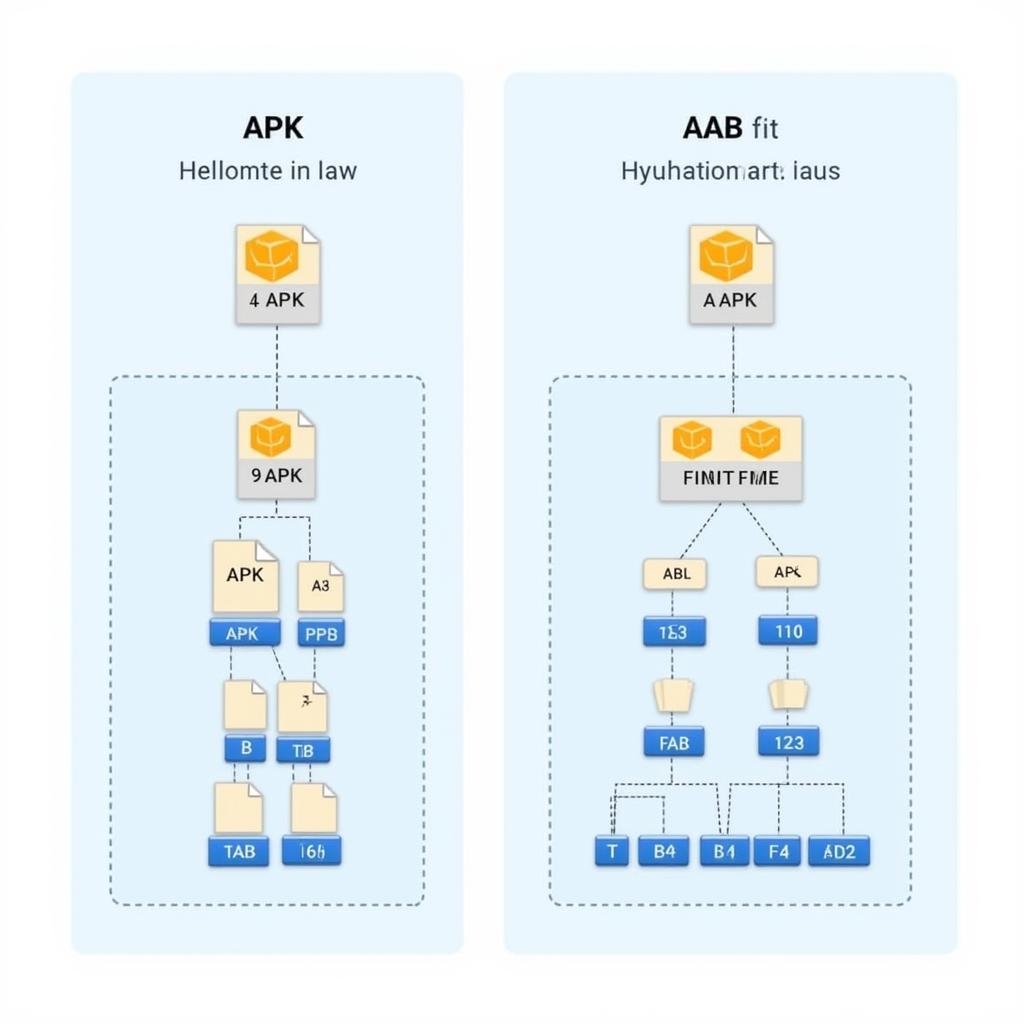When venturing into the world of Android apps, you’ll likely encounter the terms “APK” and “Android App Bundle.” Understanding the distinctions between these two formats is crucial for both developers and users, particularly when downloading apps from sources outside the Google Play Store. This article dives deep into the APK vs. Android App Bundle debate, exploring their nuances and guiding you toward the best choice for your needs.
 Comparing APK and AAB file formats for Android app distribution
Comparing APK and AAB file formats for Android app distribution
What is an APK?
APK, which stands for Android Package Kit, is the standard file format for distributing and installing applications on the Android operating system. Think of it as the equivalent of .exe files for Windows or .dmg files for macOS. APKs contain all the necessary components for an app to function, including code, resources, assets, and manifest files. For years, APKs have been the go-to method for sharing and installing Android apps, especially for those not available on the official Google Play Store. If you’ve ever sideloaded an app, you’ve interacted with an APK.
What about converting APK files? Check out how to chuyển file apk sang ipa.
What is an Android App Bundle (AAB)?
Introduced by Google in 2018, the Android App Bundle (AAB) is a publishing format that offers a more efficient way to package and distribute Android apps. Unlike APKs, which contain all resources and code for all device configurations, AABs act as a container holding all your app’s compiled code and resources. Google Play then uses this bundle to generate optimized APKs tailored to each user’s specific device configuration—screen size, CPU architecture, and language. This results in smaller download sizes and improved performance for end-users.
Key Differences Between APK and AAB
The core difference between APK and AAB lies in their distribution and installation processes. APKs are directly installable, while AABs serve as a source for generating optimized APKs. This distinction leads to several key advantages and disadvantages:
- Size: AABs inherently lead to smaller download sizes for users, as they only download the resources necessary for their specific device. This translates to faster installation times and reduced storage consumption.
- Efficiency: AABs streamline the app distribution process, especially for developers targeting a wide range of devices. With AABs, developers no longer need to create and manage multiple APK variations.
- Google Play Requirement: While APKs can be distributed through various channels, AABs are primarily used for publishing apps on the Google Play Store. For apps on Google Play, using AABs has become a requirement.
- Sideloading: Sideloading AABs directly onto a device isn’t possible. You’ll need tools like
bundletoolto generate APKs from an AAB file first.
Need the full version of VSCO? Explore apk vsco full.
Which Format is Right for You?
Choosing between APK and AAB depends primarily on your role and distribution method.
- Developers publishing on Google Play: AABs are the mandatory and recommended format. They offer significant advantages in terms of size and efficiency.
- Developers distributing apps outside Google Play: APKs remain the preferred format for sideloading and distributing apps through alternative app stores.
- Users downloading from Google Play: You’ll be interacting with optimized APKs generated from AABs without even realizing it.
- Users sideloading apps: You’ll be downloading and installing APKs directly.
 Choosing between APK and AAB for Android App Distribution
Choosing between APK and AAB for Android App Distribution
Conclusion: Embracing the Future of Android App Distribution
The Android App Bundle represents a significant evolution in Android app distribution, optimizing the experience for both developers and users. While APKs remain relevant for sideloading and alternative distribution channels, AABs are the future for apps on the Google Play Store. Understanding the strengths and limitations of each format is crucial for navigating the evolving landscape of Android app development and distribution. By choosing the right format, you can enhance the user experience and maximize the reach of your Android applications. Remember, using the correct file format, whether it’s apk và xapk, is crucial for a smooth user experience.
FAQ
- Can I convert an AAB to an APK? Yes, tools like
bundletoolallow you to generate APKs from AAB files. - Are AABs more secure than APKs? Security depends on the app itself and its development practices, not solely on the file format.
- Why are AABs mandatory on Google Play? AABs enable optimized downloads and better resource management, enhancing the user experience.
- Can I directly install an AAB on my device? No, AABs need to be converted to APKs for installation.
- What are the benefits of smaller APK sizes? Smaller APK sizes result in faster downloads, less storage consumption, and improved performance.
- Do all app stores support AABs? No, primarily Google Play utilizes the AAB format.
- Is it difficult to switch from APK to AAB for developers? Google provides comprehensive documentation and tools to facilitate the transition.
Looking for professional photo editing tools? Consider vsco apk pro. Or learn how to create APKs yourself with this guide on android project to apk.
Need more information about converting an Android project into an APK? Check out our article on “android project to apk”.
Looking for a comparison of different APK formats? Check out our article on “apk vs xapk”.
For further assistance, please contact us at Phone: 0977693168, Email: [email protected] or visit us at 219 Đồng Đăng, Việt Hưng, Hạ Long, Quảng Ninh 200000, Vietnam. We have a 24/7 customer support team.